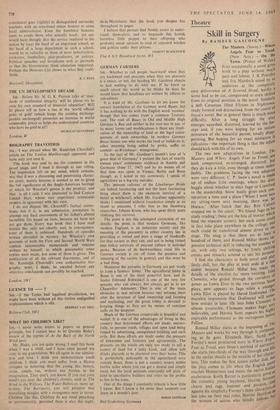Theatre
Skill in Surgery
By BAMBER GASCOIGNE The Masters. (Savoy.)—Where
Angels Fear to Tread.
(New Arts.) — On the scene had to be cut, compressed or even shift i ed from its original position in the novel. Similarly a deft Cesarean lifted Ulysses in Nighttown, ready formed and dramatised, from the centre of Joyce's novel. But in general there is much more difficulty. After a long struggle the play emerges squashed, distorted, scarred by the for- ceps and, if you were hoping for an instant miniature of the beautiful parent, totally disall- pointing. But hoping for an exact miniature Is ridiculous—the important thing is that the infant should kick with life of its own. The two new adaptations in London, The Masters and Where Angels Fear to Tread, are both compressed, re-arranged, distorted; but they do kick a little, even though at times rather feebly. The problems facing the two adaptors were very different. C. P. Snow's novel is made up of endless little meetings, where the dons haggle about whether to elect Jago or Crawford to the mastership. Snow busily gives each con- versation a time and a place (*When 1 went int° my sitting-room next morning, there was Sir Horace,' After lunch that day Roy Calvert stopped me in the court,' We found Jago in Ins study reading': these are the bits of mortar whic1,1, bind the separate scenes); but each scene could in fact take place anywhere in the college, and each could be transferred almost direct to the stage. The snag is that there are at least a hundred of them, and Ronald Millar shows un- pressive technical skill in reducing the number. to six, with only two settings, by freely shifting events and remarks around to suit his purpose. I find the characters in both novel and PlaY fairly dull, but the play at least ends at a fine canter because Ronald Millar has made the details of the election far more exciting. John, Clements, who glided through the corridors 0_1 power as Lewis Eliot in the two previous Sill plays, now appears as Jago while a YounA's, Lewis Eliot is played by David Dodimead. I"" macabre impression that Dodimead will 5011/C- how mutate in later life into John Clements IS almost irresistible. Clements makes Jago very believable, and Harold Scott repeats his hie Y enjoyable performance as the outrageous Senn/r Fellow. Ronald Millar starts at the beginning of The Masters and works his way through it, compress ing as he goes. Elizabeth Hart, faced wilhls Forster's more protracted story in Where AnFe , Fear to Tread, uses lbsen's method of narrativ.e! she starts two-thirds of the way through and fills, in the earlier details in the mouths of her charae. ters. This makes the first scenes'rather dull, bl?t the play comes to life when the English Par"„ reaches Monteriano and meets the native ltalia"_ exuberance. Keith Baxter is particularly good ans the romantic young layabout, blazing hetwefd charm and rage, humour and passion, 3"4 against his simplicity Forster's three character' last take on their real roles; Harriet Herriton:!", the woman of action who blindly follows tie'
one fixed set of prejudices; Philip Herriton, the ineffectual liberal who observes life with an amused and open mind but does nothing; and Caroline Abbott, Forster's ideal, who acts force- fully on her beliefs but is always willing to change them for better ones. In the book Philip Herriton and Caroline Abbott are in their twenties, but these serious Edwardian young persons seem so middle-aged in their attitude to hfe that I was never disturbed by the casting of Michael Denison and Dulcie Gray. His perfor- mance appeared mannered at the start, but their final scenes together were excellent.
The subject of three sailors looking for girls on their twenty-four-hour shore leave in New York was probably fine for Jerome Robbins's Original short ballet, Fancy Free, but it wears a little thin in the musical comedy version, On the l'°wn. The sailors gravitate to wherever there may be an exotic setting (the dinosaur room in the Natural History Museum, for example) or the chance of a song; typically, four of the eight scenes in Act 2 take place in different night dubs. There's a score by Bernstein which already shows the same vitality as West Side Story (On the Town was written twenty years ago) and
J
there is a delightful performance by Andrea affe as one of the girls. But on the whole the authors, Betty Comden and Adolph Green, IsPend rather too much time, like the sailors, °°kIng aimlessly around for entertainment.



































 Previous page
Previous page